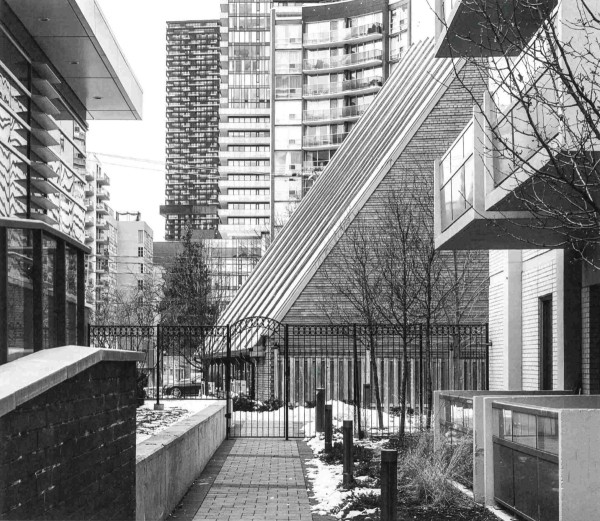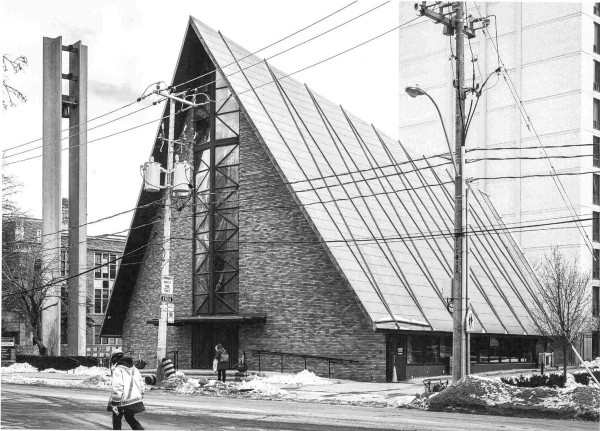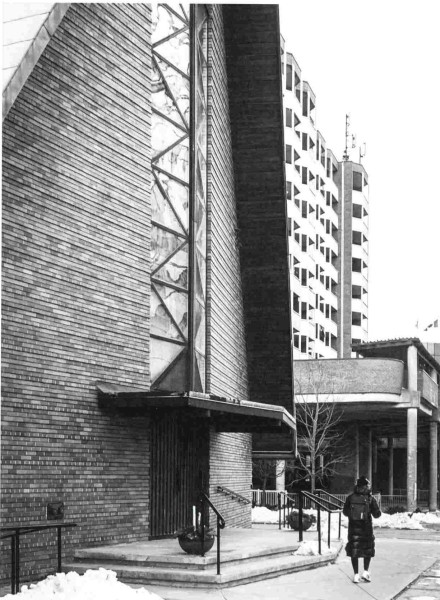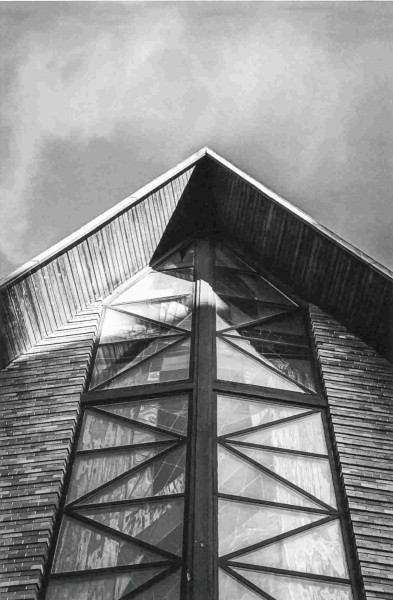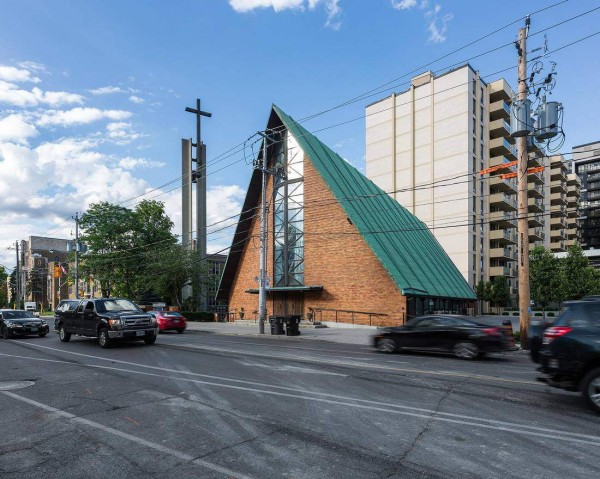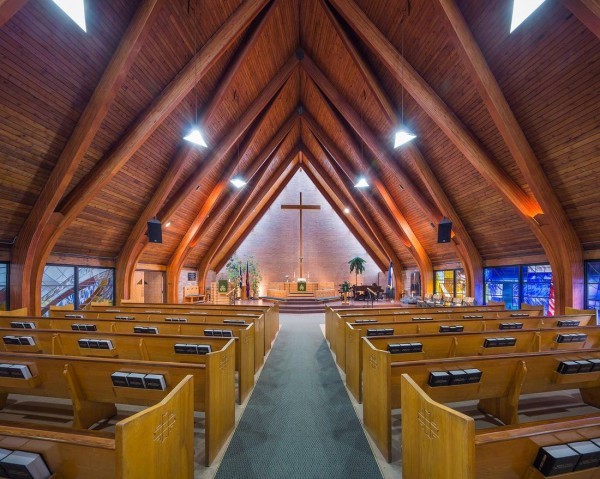In connection with the “Special Meeting” of St. Peter’s congregation called for March 25, I want to draw attention to the actions of VEMU and KESKUS (International Estonian Centre). They have been noted, but are buried in special interest articles. I want now to draw them to the attention of the larger community and the mainstream public. And it is important to acknowledge the cultural and historical significance of St. Peter’s Church for the diaspora and the value of its architectural heritage for all.
Erasing Memory
How many know that VEMU removed the name of the renowned architect of Eesti Maja’s Great Hall - and St. Peter’s Estonian Lutheran Church – in a public exhibit, by replacing it with someone else not as well known – in effect, making it disappear? Theirs would have been the official record. When Eesti Maja Estonian House is demolished, there will be no building, the sellers did not negotiate even a plaque, as the city did for the School House, and there would not be an honouring at least in memory.
The Globe and Mail published a major article, “Postwar Estonians left their mark on Toronto” about the architectural exhibit co-organized by VEMU / Estonian Studies Centre at Tartu College. It was not framed with the modernist concrete buildings that Tartu College wanted to highlight, including the Tartu College and former Rochdale College buildings designed by Elmar Tampõld. The photos are all by Estonia’s Kaido Haagen. The photos that frame the lengthy “Architourist” article by Dave LeBlanc depict “Michael Bach’s St. Peter’s Estonian Lutheran Church at 817 Mount Pleasant Rd”, and its interior, magnificent and at the same time reminiscent of an upturned boat, come to safe harbour: “St. Peter’s Estonian Lutheran Church is Bach’s masterpiece”.
Advertisement / Reklaam
Advertisement / Reklaam
At the opening Symposium, when attention was drawn to the incorrect naming of the architect of the Estonian House Grand Hall, (also photographed and incorrectly identified for the print version of The Globe and Mail), it was disclosed that the curator from Estonia, Jarmo Kauge, was not aware (he had not been informed) of the existence of Toronto Architecture: A City Guide. Alex Bozekovic’s co-authored 2017 edition introduces the “Scandinavian Modernism” variant so essential to identifying and understanding the style that Mihkel / Michael Bach brought to his celebrated teaching at the University of Toronto, to his addition of the Grand Hall to Estonian House, and to the remaining “masterpiece” of our St. Peter’s Estonian Evangelical Lutheran Church.Cultural and Historical Significance
An appreciation of the cultural and historical significance of the Columbarium at St. Peter’s Estonian Evangelical Lutheran Church must begin with an understanding that it is a memorial to spiritual leadership and the foundations of one community’s experience of displacement and settlement in Canada. It is a significant point of contact historically between cultures that continues in the lives of families and community members. And it speaks to a contemporary condition – a duty rendered to forbears, and an emerging consciousness of what it is to be a hyphenated Canadian.
Estonian-Canadians growing up in Ontario did not always see themselves or their roots in Estonia reflected in books, the media, or public discourse about vital societal themes. Their story as a community in Toronto and southwestern Ontario began with the leadership of Pastor Oskar Puhm, who is interred in the Columbarium along with others who fought forces of invasion in their homeland. The Church and its Columbarium are a gift of mental integrity in their actions after observing the horrific conditions of war. The story of the Estonian diaspora unfolds as expanding leadership and initiative, always grounded in and building on the foundation of faith, commitment, and community.
Advertisement / Reklaam
Advertisement / Reklaam
In regard to the preservation of St. Peter’s Estonian Evangelical Lutheran Church, it is worth considering what Bozekovic goes on to say in his Foreword, and what architectural photographer Amanda Large says in her Introduction, to fifty50: 50 modernist churches, a 50 mm lens. St. Peter’s Church is one of three represented with a series of four photographs, or “vignettes”, in this photographic homage to the still largely ignored subset of modernist architecture. The others are West Ellesmere United Church built in 1958 and Holy Eucharist Ukrainian Catholic Church in 1967. Built in 1955, St. Peter’s leads in the latest tally of a hundred and fifty modernist churches in the six boroughs that make up metropolitan Toronto. Bozekovic invites us to see our Scandinavian Modernism not only as a label for a different style, with its organic forms and natural materials, but we might say as an ecosystem. He points out that the Catholic Church and other Christian denominations in the sixties were engaged in a period of liberal reform that altered the rituals and consequently the design and use of buildings. The Church in Estonia did not engage in this process while the nation was occupied under the Soviet regime.
There is a movement “toward simplicity and an erasure of hierarchy, fostering an intimate connection between congregations, faith leaders, and the Divine”. This helps explain the discomfort many have felt in recent years at St. Peter’s with a foreign influence of hierarchical governance and ritual. That foreign influence may begin to account for the singular lack of activity at the church as compared to other Estonian churches in Canada. At the same time Bozekovic clarifies the tensions of adaptive reuse, and the positive challenges of achieving a fruitful balance between a familiar structure, devoid of complex functional requirements, and innovations that are adaptive to and juxtaposed with the realities of an evolving city.
Architectural Heritage and Legacy
Advertisement / Reklaam
Advertisement / Reklaam
Any consolidation of resources that treats existing diaspora properties as expendable runs counter to the heterogeneity of the community that is valued in the city and country in which the diverse Estonian community has survived and thrived. Large writes: “Beyond documenting a largely ignored subset of modernist architecture, and creating compelling imagery in its own right, fifty50 also raises questions about preservation and architectural legacy in Canadian cities, and particularly in Toronto.” Architect Alar Kongats on Oct. 30 2017 at Tartu College marked with an “X” the high-rise depicted on his first slide for the Community Consultation for the new IEC, now KESKUS. They had “listened” to the Annex community. He noted, too, that the project would restore and preserve as fully functional the heritage building at 11 Madison, not just a façade. Madison Avenue was the newest Heritage Conservation District in the Annex. Adaptive reuse is a preferred alternative to demolition from the perspectives of waste reduction and heritage preservation. Asked about funding for the as yet unbuilt VEMU building, designed by Toomas Tampõld, Project Manager Dave Kalm replied that another asset would be sold. Why is Alar Kongats voting for the closure of the Columbarium and the sale of St. Peter’s Church to a developer? Why aren’t they listening to the Estonian community? What opportunity has the community had to speak to the fate of St. Peter’s Estonian Evangelical Lutheran Church?
As Bozekovic concludes, “forms that express high spiritual ambition, and the aesthetic and technological innovations of the age, now sit quietly on overlooked suburban blocks.” St. Peter’s Church, though, is in midtown Toronto. There may be some who would rather not see it as they walk the busy street. They would rather not think of the people who are not there, or their activities, so recently described in a 2020 Toronto Metropolitan University article by student journalists. They might not even like the title “From Tragedy to Community: How Estonians preserve their culture in Toronto”, at the Estonian House, which was sold to a developer also interested in a city hub that is intensifying. Toronto Estonians have been scattered, the very young to a nearby public school in the old neighbourhood for their kindergarten. Some are now in a great rush to sell the Church – see the Friends’ Open Letter to the Congregational Council of St. Peter’s Church, keeping in mind the new hierarchy. There was a great rush to sell already in 2020, despite the pandemic, and we know what was said of St. Peter’s Church, that it was “just a building” (“To be, or not to be; That is the question” EWR & EE).
Advertisement / Reklaam
Advertisement / Reklaam
I would dispute one point that Bozekovic makes. At this point I am convinced that architectural tourists would make their way, with a shuttlebus, say, to see “a synthesis of the mundane and the heroic, the worldly and the sacred” far and wide in our great city. That is in part why over 1500 people have signed and commented on the Friends’ petition against the closure of the Columbarium and the sale of St. Peter’s Church, and in favour of their preservation. Indeed, a photograph, however brilliant, cannot give what Jarmo Kauge, the curator of the Tartu College architectural exhibit, describes to Dave LeBlanc, the Globe’s Architourist, against the backdrop of his own post-Soviet experience and travels: ‘I think it's one of the best churches I've ever been to, and I've been to Italy … It's just so cozy, and the light is perfect … I don't know, I felt so good inside this church.’"
There are a lot of signatories from the church, the community, and the broader society in favour of preserving this unique gem, and the traces of all the people who have laid foundations and helped create the beautiful diverse city we have today.
Advertisement / Reklaam
Advertisement / Reklaam






